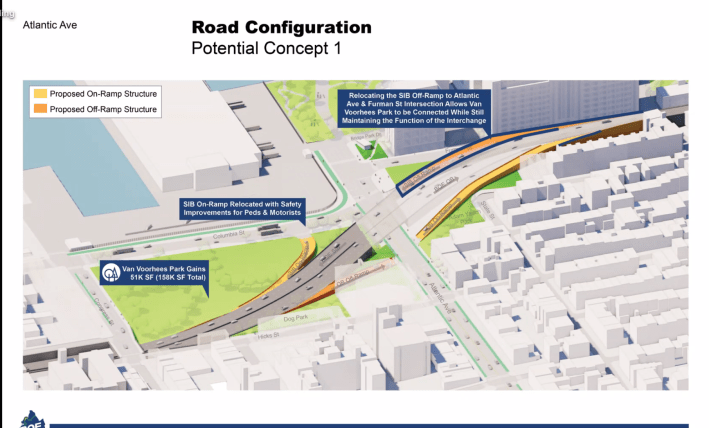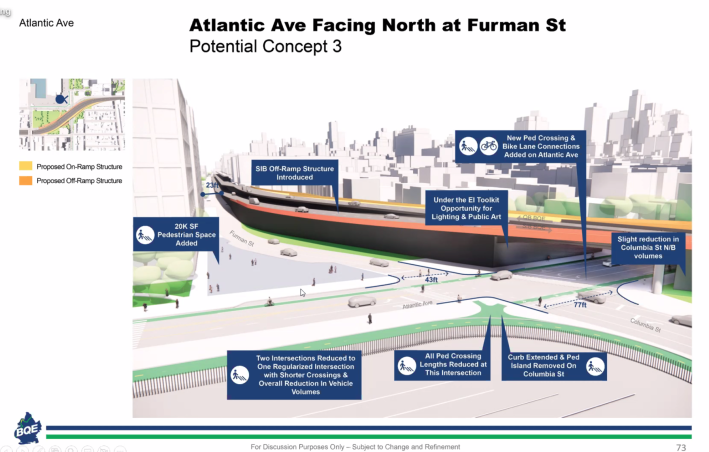The city on Thursday night unveiled three new concepts for its long-awaited redesign of the Brooklyn-Queens Expressway's interchange at Atlantic Avenue — dubbed the "worst-designed ramps" in the city — with all three bringing its Queens-bound on- and off-ramps into compliance with federal safety standards, improving pedestrian crossings, and increasing safety, though with "trade-offs," according to the Department of Transportation.
Officials acknowledged shortcomings with each concept, but defended all three as “focusing on safety and enhanced connections” with the potential to reunite Van Voorhees Park, which is currently bifurcated by the Staten Island-bound on- and off-ramps.
Each concept also includes a “buffered or protected” bike lane along that stretch of Atlantic Avenue in both directions.
“I’ll be frank, it’s unlikely that there is a perfect solution for this intersection that accommodates all needs, so our work here has focused on being clear about trade-offs, balancing individual user needs and prioritizing safety,” said DOT’s Julie Bero during a virtual presentation on Thursday night.
But critics blasted the agency for putting cars and trucks before pedestrians and cyclists, and doing nothing to change the status quo of traffic volumes, writing myriad criticisms in the comments section of the presentation, including that DOT has “little regard for our safety”; that “none of the concepts are (sic) acceptable”; and that they are all “unbelievably disappointing.”
“None of these designs consider anything transformative for the corridor,” wrote Erika Worth.
Still, officials say all three options — which all feature a three-lane BQE, not two — will vastly improve the dangerous area, where just two months ago, a motorist fatally struck 31-year-old Katherine Harris as she was crossing Atlantic Avenue at Clinton Street.

“These concepts all strive to improve the intersection of Atlantic Avenue, Furman Street and Columbia street,” said Mike Flynn of Sam Schwartz Engineering, which is working on the design concepts on behalf of the city.
And much to locals’ chagrin, Flynn added that the existing BQE over Atlantic Avenue will be maintained as it is in “very good condition and doesn't need replacement at this time.”
“The bridge doesn’t preclude you from doing any number of good designs and infrastructure to connect communities. The bridge (sic) its ownership and condition are (sic) convenient excuse,” said Amy Breedlove, who leads BQE advocacy for the Cobble Hill Association.
First, before looking at the three concepts, here's a zoomable map of the area:
Concept 1

- Relocate the Staten Island-bound off-ramp to the north side of Atlantic Avenue and shift the Staten Island bound on-ramp further north within Van Voorhees Park, allowing for a reconnected park of increased size.
- Pedestrian crossings reduced with the removal of slip lanes at Queens-bound on- and off-ramps on Atlantic Avenue
- Bike lanes on the north and south side of Atlantic Avenue would provide direct access to waterfront greenway
- Two potential variations: 1A, Furman Street would remain in its existing location, allowing for shorter crossing distances and the removal of the pedestrian island. 1B, the north-bound lane of Furman Street would be shifted to be adjacent to the BQE structure with the Staten Island-bound off-ramp sitting in between, allowing for north-bound traffic coming from Columbia Street to directly connect into Furman Street with fewer conflicts with pedestrians
“Concept 1 improves walking conditions, especially on Atlantic Avenue and reconnects Van Voorhees park. But it does not reduce traffic volumes on Atlantic Avenue and it’s likely to increase congestion on Atlantic and reduce vehicle speeds, including for buses, potentially creating a more challenging pedestrian experience,” said Flynn.
Concept 2

- Builds off of concept 1
- A second Queens-bound on ramp would be added at the intersection of Hicks and Congress streets
- Pedestrian crossing distances would be reduced at the Queens-bound on-and-off ramps
- Splits Furman Street
- The north bridge over the BQE on Congress Street would be widened to accommodate expected new volume of vehicles
- Would also include a widened sidewalk
- Added ramp structure at Hicks Street for Queens-bound traffic would relieve pressure on Atlantic Avenue
- Include left-turn restriction from Atlantic Avenue to Queens-bound BQE on-ramp to significantly reduce pedestrian conflicts
“Concept 2 improves walking conditions and reduces crossing distances throughout, especially on Atlantic Avenue, and reduces congestion on Atlantic. The concept improves walking conditions on Columbia Street to connect to Van Voorhees Park, increasing the park by about 50,000 square feet. The addition of a Queens-bound on-ramp helps to alleviate chronic congestion on Atlantic Avenue, however this impacts the existing dog park, reducing the space by approximately 500 square feet,” said Flynn.
Concept 3

- Represents the most notable change
- New ramp structures would be introduced in both directions
- Staten Island-bound off-ramp would exit onto Congress Street at Hicks street
- Enlarged space at the foot of Furman Street reclaiming 20,000 sq ft for pedestrians
- Two potential variations: 3A would allow Congress Street to operate as two-way. enabling trucks and cars to turn right onto Congress Street toward Columbia Street; 3B would remove the Queens-bound on-ramp
“Concept 3 also improves walking conditions and reduces crossing distances throughout, especially on Atlantic Avenue. This concept shifts the Staten Island-bound off-ramp onto Congress and Hicks streets, transforming Congress into a two-way street and shifting a limited amount of traffic exiting the BQE onto that street,” said Flynn. “In concept 3B, the Queens-bound on-ramp at Atlantic avenue would be removed, this would create an uninterrupted pedestrian connection on the north side of Atlantic Avenue. While this would be a noticeable safety improvement for pedestrians and bicyclists, the closure of this on-ramp would likely have cascading effects for traffic in the neighborhood.”
The executive director of the Atlantic Avenue Business Improvement District, Kelly Carroll, echoed the concerns of all the other critics, saying that Concept 1 would be the “least harmful” if she “had to pick a poison.”
And others added that creating another on-ramp on Hicks Street would turn what should be a narrow, residential roadway into yet another deadly speedway in the neighborhood.
“This feels like a trick. Don’t like option 1? Meet OPTION TWO — making Hicks Street a highway,” Amanda Nichols wrote in the comments section during the presentation.

DOT’s Julie Bero said that Thursday’s meeting is “by no means the end of engagement on this topic.”






